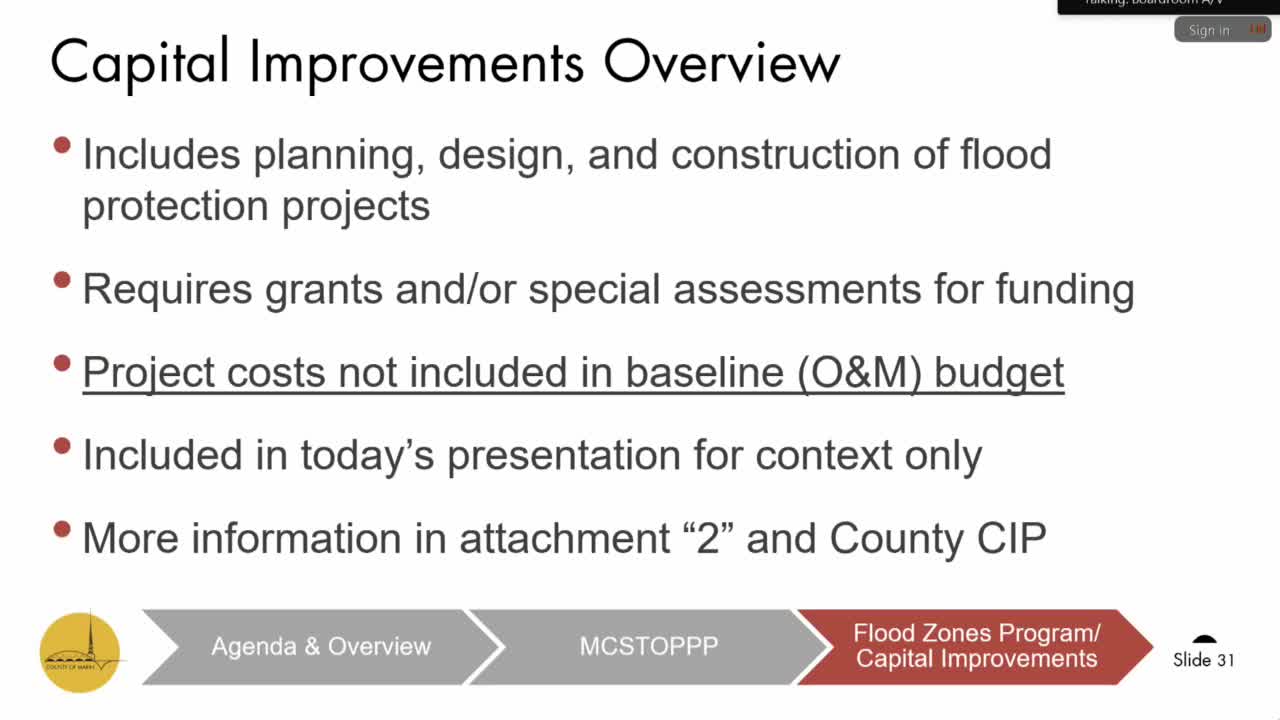Marin County presents new flood control projects and funding challenges
May 21, 2025 | Marin County, California
This article was created by AI summarizing key points discussed. AI makes mistakes, so for full details and context, please refer to the video of the full meeting. Please report any errors so we can fix them. Report an error »

In the heart of Marin County, a pivotal government meeting unfolded, shedding light on the ambitious plans for flood control and infrastructure improvements. As officials gathered, the focus was clear: the Capital Improvement Program (CIP) aims to enhance flood resilience and maintain vital infrastructure across the region.
The meeting revealed that the CIP encompasses a range of projects, from planning and design to construction, all aimed at addressing the pressing challenges of flooding and infrastructure maintenance. Notably, these projects often rely on external grant funding, highlighting the importance of securing financial support for their success. Each project requires individual board approval for expenditures, ensuring that every dollar is accounted for in the county's budget.
Among the key projects discussed was the Deer Island Bridal Restoration Project, set to begin construction next year. Located in Novato's Flood Zone 1, this initiative aims to restore tidal marshes and construct an ecotone levee, significantly reducing the impact of flooding and future sea level rise. With an estimated cost of $11.4 million, the project is primarily funded through grants, showcasing a collaborative effort to protect the environment and local communities.
Another significant project is the Cardinal Road Levy Project in Richardson Bay, designed to provide flood protection for Tam Valley. This project addresses critical issues such as levee seepage and gopher damage, featuring a robust 1,100-foot sheet pile wall. Construction is targeted to start in 2027, with a preliminary cost estimate of $4.6 million.
The Santa Venetia flood wall project, a high-priority initiative, aims to replace over 1.5 miles of flood wall to enhance protection against levee failure and overtopping during high water events. However, this project faces considerable challenges, including a significant funding shortfall. With only $37,000 currently available against an estimated $30 million cost, officials are exploring community engagement for a special assessment to help close the funding gap. The urgency of this project is underscored by rising maintenance costs for temporary flood protection measures, leaving the area vulnerable until construction can begin.
In the Ross Valley, the Lower Corte Madera Creek habitat restoration project aims to revitalize the downstream end of the concrete channel. This initiative not only enhances the natural landscape by replanting native vegetation but also plays a crucial role in reducing flood risk.
As the meeting concluded, it was evident that Marin County is at a crossroads, balancing the need for immediate flood protection with the long-term vision of sustainable infrastructure. The discussions highlighted the importance of community involvement and innovative funding solutions as the county navigates the complexities of these vital projects. With the stakes high and the clock ticking, the path forward will require collaboration, creativity, and a steadfast commitment to safeguarding Marin's future against the ever-present threat of flooding.
The meeting revealed that the CIP encompasses a range of projects, from planning and design to construction, all aimed at addressing the pressing challenges of flooding and infrastructure maintenance. Notably, these projects often rely on external grant funding, highlighting the importance of securing financial support for their success. Each project requires individual board approval for expenditures, ensuring that every dollar is accounted for in the county's budget.
Among the key projects discussed was the Deer Island Bridal Restoration Project, set to begin construction next year. Located in Novato's Flood Zone 1, this initiative aims to restore tidal marshes and construct an ecotone levee, significantly reducing the impact of flooding and future sea level rise. With an estimated cost of $11.4 million, the project is primarily funded through grants, showcasing a collaborative effort to protect the environment and local communities.
Another significant project is the Cardinal Road Levy Project in Richardson Bay, designed to provide flood protection for Tam Valley. This project addresses critical issues such as levee seepage and gopher damage, featuring a robust 1,100-foot sheet pile wall. Construction is targeted to start in 2027, with a preliminary cost estimate of $4.6 million.
The Santa Venetia flood wall project, a high-priority initiative, aims to replace over 1.5 miles of flood wall to enhance protection against levee failure and overtopping during high water events. However, this project faces considerable challenges, including a significant funding shortfall. With only $37,000 currently available against an estimated $30 million cost, officials are exploring community engagement for a special assessment to help close the funding gap. The urgency of this project is underscored by rising maintenance costs for temporary flood protection measures, leaving the area vulnerable until construction can begin.
In the Ross Valley, the Lower Corte Madera Creek habitat restoration project aims to revitalize the downstream end of the concrete channel. This initiative not only enhances the natural landscape by replanting native vegetation but also plays a crucial role in reducing flood risk.
As the meeting concluded, it was evident that Marin County is at a crossroads, balancing the need for immediate flood protection with the long-term vision of sustainable infrastructure. The discussions highlighted the importance of community involvement and innovative funding solutions as the county navigates the complexities of these vital projects. With the stakes high and the clock ticking, the path forward will require collaboration, creativity, and a steadfast commitment to safeguarding Marin's future against the ever-present threat of flooding.
View full meeting
This article is based on a recent meeting—watch the full video and explore the complete transcript for deeper insights into the discussion.
View full meeting
